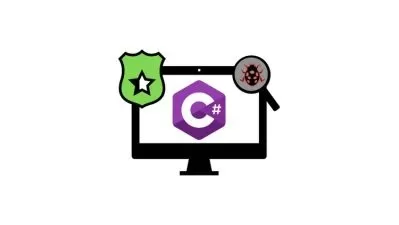API Design Patterns, video edition
Focused View
16:37:47
80 View
01-Part 1. Introduction.mp4
01:07
02-Chapter 1. Introduction to APIs.mp4
07:11
03-Chapter 1. What are resource-oriented APIs.mp4
09:47
04-Chapter 1. Expressive.mp4
10:30
05-Chapter 2. Introduction to API design patterns.mp4
08:23
06-Chapter 2. Why are API design patterns important.mp4
07:10
07-Chapter 2. Anatomy of an API design pattern.mp4
12:11
08-Chapter 2. Case study - Twapi, a Twitter-like API.mp4
07:51
09-Chapter 2. Exporting data.mp4
07:33
10-Part 2. Design principles.mp4
00:49
11-Chapter 3. Naming.mp4
09:52
12-Chapter 3. Language, grammar, and syntax.mp4
12:02
13-Chapter 3. Syntax.mp4
09:52
14-Chapter 3. Case study - What happens when you choose bad names.mp4
07:50
15-Chapter 4. Resource scope and hierarchy.mp4
08:39
16-Chapter 4. Types of relationships.mp4
07:15
17-Chapter 4. Choosing the right relationship.mp4
07:22
18-Chapter 4. References or in-line data.mp4
05:53
19-Chapter 4. Anti-patterns.mp4
11:13
20-Chapter 5. Data types and defaults.mp4
09:21
21-Chapter 5. Booleans.mp4
07:23
22-Chapter 5. Bounds.mp4
07:41
23-Chapter 5. Strings.mp4
11:25
24-Chapter 5. Enumerations.mp4
11:59
25-Chapter 5. Maps.mp4
10:40
26-Part 3. Fundamentals.mp4
01:01
27-Chapter 6. Resource identification.mp4
06:39
28-Chapter 6. Permanent.mp4
07:47
29-Chapter 6. What does a good identifier look like.mp4
08:38
30-Chapter 6. Checksums.mp4
07:51
31-Chapter 6. Implementation.mp4
09:13
32-Chapter 6. Tomb-stoning.mp4
09:03
33-Chapter 6. What about UUIDs.mp4
05:47
34-Chapter 7. Standard methods.mp4
10:56
35-Chapter 7. Idempotence and side effects.mp4
09:46
36-Chapter 7. List.mp4
10:24
37-Chapter 7. Update.mp4
07:36
38-Chapter 7. Replace.mp4
06:49
39-Chapter 8. Partial updates and retrievals.mp4
10:15
40-Chapter 8. Implementation.mp4
08:26
41-Chapter 8. Repeated fields.mp4
09:31
42-Chapter 8. Implicit field masks.mp4
09:21
43-Chapter 8. Trade-offs.mp4
07:15
44-Chapter 9. Custom methods.mp4
10:27
45-Chapter 9. Overview.mp4
07:46
46-Chapter 9. Resources vs. collections.mp4
10:32
47-Chapter 10. Long-running operations.mp4
09:09
48-Chapter 10. Implementation.mp4
07:00
49-Chapter 10. Resolution.mp4
07:24
50-Chapter 10. Error handling.mp4
09:48
51-Chapter 10. Pausing and resuming operations.mp4
05:49
52-Chapter 10. Persistence.mp4
07:35
53-Chapter 11. Rerunnable jobs.mp4
10:43
54-Chapter 11. The custom run method.mp4
10:09
55-Part 4. Resource relationships.mp4
01:11
56-Chapter 12. Singleton sub-resources.mp4
07:51
57-Chapter 12. Implementation.mp4
06:58
58-Chapter 12. Hierarchy.mp4
06:11
59-Chapter 13. Cross references.mp4
08:35
60-Chapter 13. Value vs. reference.mp4
05:36
61-Chapter 14. Association resources.mp4
09:45
62-Chapter 14. Uniqueness.mp4
09:49
63-Chapter 15. Add and remove custom methods.mp4
12:45
64-Chapter 16. Polymorphism.mp4
09:20
65-Chapter 16. Polymorphic structure.mp4
10:27
66-Chapter 16. Why not polymorphic methods.mp4
08:28
67-Part 5. Collective operations.mp4
01:22
68-Chapter 17. Copy and move.mp4
07:48
69-Chapter 17. Identifiers.mp4
08:15
70-Chapter 17. Related resources.mp4
10:42
71-Chapter 17. Inherited metadata.mp4
07:50
72-Chapter 17. Atomicity.mp4
06:48
73-Chapter 18. Batch operations.mp4
10:38
74-Chapter 18. Ordering of results.mp4
10:37
75-Chapter 18. Batch Delete.mp4
10:59
76-Chapter 19. Criteria-based deletion.mp4
09:42
77-Chapter 19. Validation only by default.mp4
11:44
78-Chapter 20. Anonymous writes.mp4
08:59
79-Chapter 20. Consistency.mp4
08:21
80-Chapter 21. Pagination.mp4
11:49
81-Chapter 21. Page tokens.mp4
09:04
82-Chapter 21. Total count.mp4
09:29
83-Chapter 22. Filtering.mp4
05:43
84-Chapter 22. Structure.mp4
07:36
85-Chapter 22. Filter syntax and behavior - Part 1.mp4
08:14
86-Chapter 22. Filter syntax and behavior - Part 2.mp4
09:04
87-Chapter 22. Filter syntax and behavior - Part 3.mp4
07:16
88-Chapter 23. Importing and exporting.mp4
08:42
89-Chapter 23. Implementation.mp4
09:51
90-Chapter 23. Consistency.mp4
11:09
91-Chapter 23. Failures and retries.mp4
08:30
92-Chapter 23. Filtering and field masks.mp4
08:24
93-Part 6. Safety and security.mp4
01:14
94-Chapter 24. Versioning and compatibility.mp4
07:27
95-Chapter 24. Defining backward compatibility - Part 1.mp4
09:05
96-Chapter 24. Defining backward compatibility - Part 2.mp4
10:24
97-Chapter 24. Implementation.mp4
12:41
98-Chapter 24. Semantic versioning.mp4
07:42
99-Chapter 24. Trade-offs.mp4
06:50
100-Chapter 24. Happiness vs. ubiquity.mp4
07:11
101-Chapter 25. Soft deletion.mp4
09:50
102-Chapter 25. Modifying standard methods.mp4
09:40
103-Chapter 25. Expiration.mp4
10:53
104-Chapter 26. Request deduplication.mp4
09:43
105-Chapter 26. Response caching.mp4
11:47
106-Chapter 27. Request validation.mp4
09:39
107-Chapter 27. External dependencies.mp4
06:56
108-Chapter 28. Resource revisions.mp4
09:53
109-Chapter 28. Creating revisions.mp4
11:06
110-Chapter 28. Restoring a previous revision.mp4
11:48
111-Chapter 29. Request retrial.mp4
07:13
112-Chapter 29. Server-specified retry timing.mp4
09:22
113-Chapter 29. Retry After.mp4
06:55
114-Chapter 30. Request authentication.mp4
10:15
115-Chapter 30. Implementation.mp4
06:23
116-Chapter 30. Request fingerprinting.mp4
05:56
117-Chapter 30. Including the signature.mp4
08:43
More details
User Reviews
Rating
average 0
Focused display
Category

O'Reilly
View courses O'ReillyO'Reilly Media is an American learning company established by Tim O'Reilly that publishes books, produces tech conferences, and provides an online learning platform. Its distinctive brand features a woodcut of an animal on many of its book covers.
- language english
- Training sessions 117
- duration 16:37:47
- Release Date 2023/11/06






















